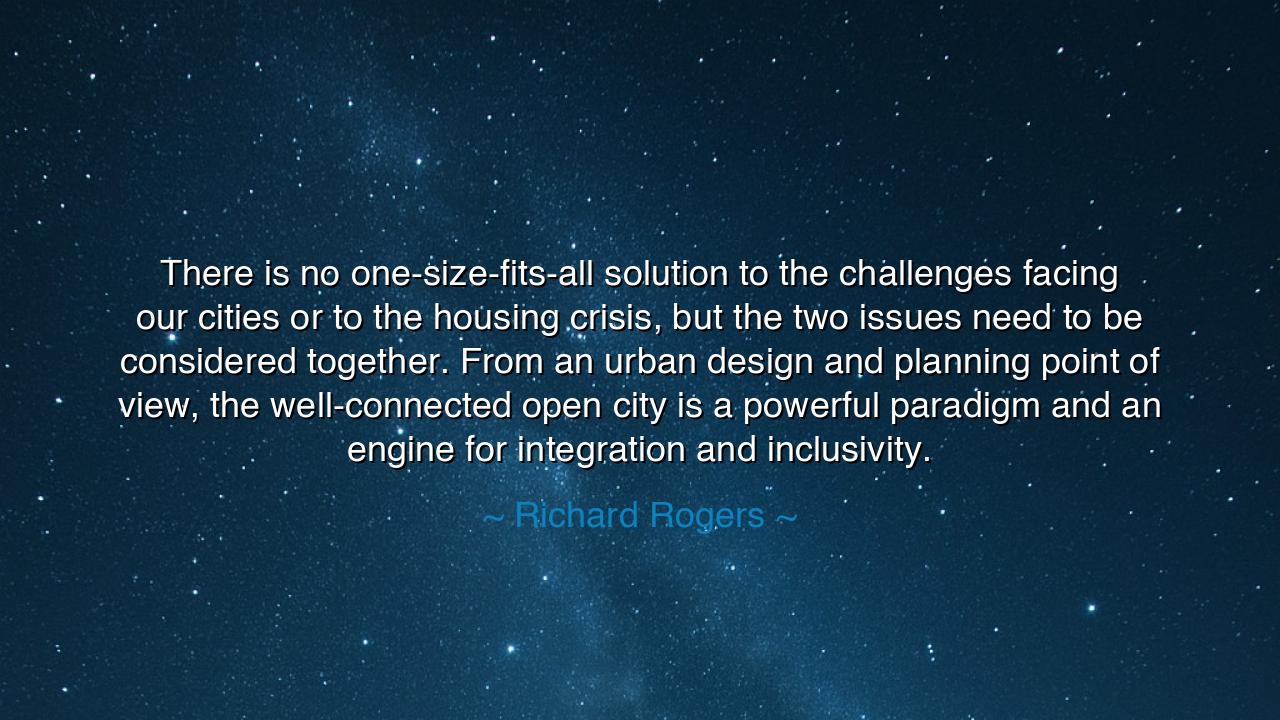
There is no one-size-fits-all solution to the challenges facing
There is no one-size-fits-all solution to the challenges facing our cities or to the housing crisis, but the two issues need to be considered together. From an urban design and planning point of view, the well-connected open city is a powerful paradigm and an engine for integration and inclusivity.






“There is no one-size-fits-all solution to the challenges facing our cities or to the housing crisis, but the two issues need to be considered together. From an urban design and planning point of view, the well-connected open city is a powerful paradigm and an engine for integration and inclusivity.” – Richard Rogers
In these thoughtful and visionary words, Richard Rogers, one of the great philosophers of architecture and urbanism, speaks not only of buildings and streets, but of the soul of civilization itself. His insight reminds us that cities are not merely structures of stone and steel — they are living organisms, reflections of our shared humanity. When he speaks of the “open city,” he speaks of a city that breathes — where walls do not divide but invite, where pathways connect rather than isolate, and where every citizen, regardless of origin or wealth, can find a place of belonging. For Rogers, architecture was never just about aesthetics; it was about justice, connection, and the building of communities that sustain the human spirit.
The origin of this quote arises from Rogers’ lifelong dedication to designing cities that unite rather than segregate. Born in Florence and raised in London, he saw firsthand how cities could inspire or alienate, depending on how they were built. Through his work — from the Pompidou Centre in Paris to the Millennium Dome in London and the Madrid Barajas Airport — he championed the principle of transparency and openness, not only in materials but in meaning. His belief was simple yet revolutionary: that design must serve democracy. A city that welcomes all, he argued, is not just a space of habitation — it is a mirror of the society’s conscience.
When Rogers says there is “no one-size-fits-all solution,” he warns us against the arrogance of uniformity — the idea that one model, one ideology, or one system can heal the complex wounds of our urban world. Cities, he understood, are as diverse as the people who live in them. Their challenges — poverty, congestion, inequality, alienation — cannot be met by rigid formulas. Instead, each city must be treated as a unique ecosystem, nurtured with empathy and wisdom. The housing crisis, which often separates the poor from the prosperous and the worker from the workplace, cannot be solved apart from the design of the city itself. To Rogers, housing and urban design are two sides of the same moral coin — for how we house our people determines how we value them.
History offers both warnings and inspirations for his truth. Consider Haussmann’s Paris of the nineteenth century — a city reborn in grandeur, its boulevards wide and luminous. Yet in that beauty, the poor were displaced, their homes razed for the sake of vision without compassion. Contrast this with Copenhagen, a city that chose inclusivity over spectacle. Its neighborhoods weave together housing, parks, transport, and commerce in a seamless tapestry, so that rich and poor alike share the same air and light. This is the well-connected open city Rogers envisions — not a monument to power, but a living promise of equality, a city that thrives because its people are not divided.
The open city, in Rogers’ philosophy, is more than physical form — it is a state of mind. It is a city of permeability, where spaces belong to all and no one is walled off by wealth or fear. It invites integration rather than exclusion, creating conditions where diversity becomes strength, not tension. In such a city, the street is the stage of democracy, the park a temple of common ground, and the home a sanctuary of dignity. The power of design, when guided by moral clarity, becomes not just a craft, but a form of social healing. Rogers believed that a city open in its design could be open in its heart — that architecture itself could become an act of hope.
Yet his words carry a challenge to every generation of builders, leaders, and citizens: to remember that inclusivity is not automatic. It must be designed, nurtured, and protected. The danger of the modern age is not scarcity of space, but scarcity of vision. Cities rise higher and faster, yet too often they become fortresses of wealth, where the few look down upon the many. Rogers calls us back to first principles: that design must begin not with ego, but with empathy; not with the skyline, but with the street; not with abstraction, but with the human experience.
The lesson, then, is clear: a city that closes itself — to the poor, the immigrant, the dreamer — will eventually suffocate under its own walls. But a city that opens itself — that welcomes difference, that links rather than isolates — becomes an engine of renewal. As Rogers teaches, this openness is both a physical and a moral architecture, built with compassion as much as with steel. It is within our power, as citizens and creators, to ensure that our cities are not cages of inequality, but gardens of connection.
So, my listener, carry this wisdom into your own craft and community: build bridges, not barriers. In your neighborhood, in your policies, in your choices, design from the spirit of openness. Seek connection, for in connection lies humanity’s strength. For as Richard Rogers reminds us, the well-connected open city — like the well-connected human heart — is the truest engine of integration, inclusivity, and enduring civilization.






AAdministratorAdministrator
Welcome, honored guests. Please leave a comment, we will respond soon